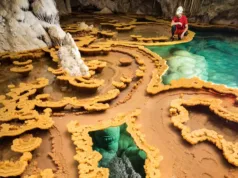Pildappa Rock is a remarkable geological formation located in South Australia, known for its unique and intriguing features.


Location and Geographical Context: Pildappa Rock is situated in the Eyre Peninsula region of South Australia, approximately 18 kilometers northwest of Minnipa. This remote and semi-arid region is characterized by vast plains, agricultural land, and a scattering of ancient rocky outcrops. Pildappa Rock stands out prominently in this landscape.
Description of the Rock Formation: Pildappa Rock is a natural granite inselberg, or monolith, that rises dramatically from the surrounding flat terrain. Its most distinctive feature is the large and exceptionally smooth sloping surface on its northern side, which is often referred to as the “Pildappa Rock Slide.” This surface is incredibly steep and covered with polished, undulating, and wave-like patterns formed by the natural weathering of the granite.
The rock itself is composed of pinkish-grey granite, and its exposed surfaces have been eroded over millions of years, resulting in its striking appearance. The rock covers an extensive area and can be explored through walking tracks and paths, offering visitors an opportunity to admire its unique geological formations and stunning views of the surrounding landscape.

Significance and Uniqueness: Pildappa Rock is unique and significant for several reasons:
- Geological Wonder: The rock’s smooth and polished surface, particularly on the northern side, is a rare geological feature. The rock’s patterns and textures, formed by natural weathering processes, make it a fascinating subject for geologists and nature enthusiasts.
- Recreational and Tourist Attraction: Pildappa Rock attracts both tourists and locals alike. Visitors can enjoy picnics, bushwalks, and rock climbing. The Pildappa Rock Slide, in particular, is a popular spot for sliding down the smooth surface, making it a unique recreational activity in a natural setting.
- Aboriginal Cultural Heritage: Pildappa Rock holds cultural significance for the local Aboriginal people, the Barngarla. It is believed to have spiritual and cultural importance and is used for various traditional practices and ceremonies.
- Botanical Diversity: The surrounding area is home to a variety of native flora, including colorful wildflowers that bloom during certain times of the year, adding to the natural beauty and appeal of the site.
In summary, Pildappa Rock is a remarkable geological formation with a unique and polished granite surface that sets it apart from other natural landmarks. Its significance extends beyond its geology, as it plays a role in the cultural heritage of the region and offers a range of recreational and educational opportunities for those who visit.
Geological Formation

Pildappa Rock is a natural granite inselberg, a type of monolithic rock formation that has been sculpted by geological processes over millions of years. This formation is primarily composed of granite, and its unique features are a result of erosion and weathering.
Formation Process:
The formation of Pildappa Rock can be attributed to the following geological processes:
- Intrusion: Initially, molten granite material from the Earth’s mantle intruded into the existing rock layers beneath the surface. This intrusion occurred millions of years ago, forming a large granite pluton deep within the Earth.
- Exposure: Over time, tectonic movements and erosion processes gradually exposed the once-buried granite pluton at the Earth’s surface.
- Erosion: The exposed granite was subjected to the forces of erosion, including wind, rain, temperature fluctuations, and freeze-thaw cycles. These processes wore down the granite surface, creating the unique undulating and polished features, particularly on the northern side of Pildappa Rock.
- Differential Weathering: The composition and structure of granite vary, and different minerals within it weather at different rates. This differential weathering led to the formation of the distinctive patterns and textures seen on the rock’s surface.
Composition and Structure:
Pildappa Rock is primarily composed of granite, a type of igneous rock. Granite is made up of various minerals, including feldspar, quartz, and mica. The specific composition and proportions of these minerals can vary, contributing to the rock’s color and texture. The rock’s structure is massive and monolithic, rising prominently from the surrounding landscape.
Geological History:
The geological history of Pildappa Rock is intertwined with the broader geological history of the region. The granite intruded into the Earth’s crust during the Precambrian era, making it incredibly ancient, dating back more than 600 million years. The formation of the rock continued as it was gradually exposed and shaped by erosion and weathering processes over geological time scales.
Comparison with Other Rock Formations:
Pildappa Rock’s uniqueness lies in its highly polished and undulating surface, which is relatively uncommon among granite formations. While granite inselbergs and monoliths are found in various places worldwide, the specific patterns and textures seen on Pildappa Rock’s northern face set it apart. Some of the world’s most famous granite formations include Uluru (Ayers Rock) in Australia, Stone Mountain in the United States, and the Enchanted Rock in Texas. Each of these formations has its own distinct characteristics and geological histories, but Pildappa Rock’s polished surface makes it stand out among granite monoliths.
Pildappa Rock in Popular Culture

Pildappa Rock may not be as well-known on a global scale as some other natural landmarks, but it holds a special place in Australian and regional culture. While it may not have received extensive recognition in popular culture, it has made appearances in regional and local media, and it holds cultural significance to the Barngarla people and those who appreciate its unique geological features.
- Local Media and Tourism: Pildappa Rock is often featured in South Australian and regional tourism promotions and travel guides. It is a popular destination for both tourists and locals, attracting those interested in experiencing its unique geological formations and engaging in recreational activities such as rock sliding.
- Outdoor Enthusiasts: Pildappa Rock’s distinctive features make it appealing to outdoor enthusiasts, such as rock climbers and hikers. It offers opportunities for adventure and exploration in a natural setting, drawing attention from individuals and groups looking to engage in outdoor activities.
- Geological Interest: While not a household name, Pildappa Rock is recognized by geologists and earth science enthusiasts who appreciate its unique and unusual geological attributes. Its polished surface and the patterns created by natural weathering make it an intriguing subject for those interested in the Earth’s geological history.
- Aboriginal Cultural Significance: Pildappa Rock is of cultural significance to the Barngarla people, the traditional owners of the land. Although it may not feature prominently in mainstream popular culture, its cultural importance is acknowledged within Aboriginal communities and events in the region.
- Art and Photography: The striking appearance of Pildappa Rock has inspired artists and photographers, both locally and regionally. Its unique features and the interplay of light and shadows on its surface have made it a subject of creative expression.
- Regional Events: Pildappa Rock may play a role in local or regional events and festivals, particularly those celebrating the natural and cultural heritage of the Eyre Peninsula. It might feature in storytelling, educational programs, or exhibitions related to the region’s unique attractions.
While Pildappa Rock may not have the global recognition of iconic landmarks like Uluru or the Grand Canyon, it has carved out a place in the cultural and recreational life of South Australia and the Eyre Peninsula. Its unique geological features, cultural significance, and outdoor recreational opportunities ensure it remains an interesting and appreciated part of the local culture and landscape.




































